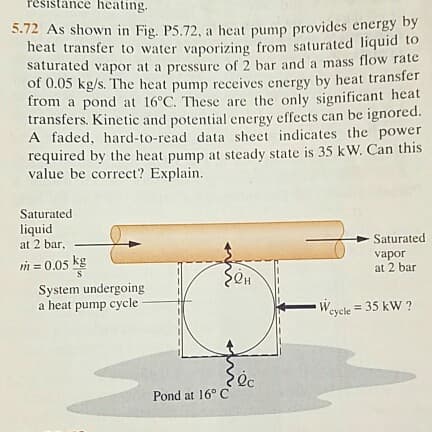5.72 As shown in Fig. P5.72, a heat pump provides energy by heat transfer to water vaporizing from saturated liquid to saturated vapor at a pressure of 2 bar and a mass flow rate of 0.05 kg/s. The heat pump receives energy by heat transfer from a pond at 16°C. These are the only significant heat transfers. Kinetic and potential energy effects can be ignored. A faded, hard-to-read data sheet indicates the power required by the heat pump at steady state is 35 kW. Can this value be correct? Explain. Saturated
5.72 As shown in Fig. P5.72, a heat pump provides energy by heat transfer to water vaporizing from saturated liquid to saturated vapor at a pressure of 2 bar and a mass flow rate of 0.05 kg/s. The heat pump receives energy by heat transfer from a pond at 16°C. These are the only significant heat transfers. Kinetic and potential energy effects can be ignored. A faded, hard-to-read data sheet indicates the power required by the heat pump at steady state is 35 kW. Can this value be correct? Explain. Saturated
Elements Of Electromagnetics
7th Edition
ISBN:9780190698614
Author:Sadiku, Matthew N. O.
Publisher:Sadiku, Matthew N. O.
ChapterMA: Math Assessment
Section: Chapter Questions
Problem 1.1MA
Related questions
Question
?

Transcribed Image Text:resistan
ce heating.
5.72 As shown in Fig. P5.72, a heat pump provides energy by
heat transfer to water vaporizing from saturated liquid to
saturated vapor at a pressure of 2 bar and a mass flow rate
of 0.05 kg/s. The heat pump receives energy by heat transfer
from a pond at 16°C. These are the only significant heat
transfers. Kinetic and potential energy effects can be ignored.
A faded, hard-to-read data sheet indicates the power
required by the heat pump at steady state is 35 kW. Can this
value be correct? Explain.
Saturated
liquid
at 2 bar.
Saturated
m = 0.05 kg
vapor
at 2 bar
System undergoing
a heat pump cycle
cycle = 35 kW ?
Pond at 16° C
Expert Solution
This question has been solved!
Explore an expertly crafted, step-by-step solution for a thorough understanding of key concepts.
This is a popular solution!
Trending now
This is a popular solution!
Step by step
Solved in 2 steps with 2 images

Knowledge Booster
Learn more about
Need a deep-dive on the concept behind this application? Look no further. Learn more about this topic, mechanical-engineering and related others by exploring similar questions and additional content below.Recommended textbooks for you

Elements Of Electromagnetics
Mechanical Engineering
ISBN:
9780190698614
Author:
Sadiku, Matthew N. O.
Publisher:
Oxford University Press

Mechanics of Materials (10th Edition)
Mechanical Engineering
ISBN:
9780134319650
Author:
Russell C. Hibbeler
Publisher:
PEARSON

Thermodynamics: An Engineering Approach
Mechanical Engineering
ISBN:
9781259822674
Author:
Yunus A. Cengel Dr., Michael A. Boles
Publisher:
McGraw-Hill Education

Elements Of Electromagnetics
Mechanical Engineering
ISBN:
9780190698614
Author:
Sadiku, Matthew N. O.
Publisher:
Oxford University Press

Mechanics of Materials (10th Edition)
Mechanical Engineering
ISBN:
9780134319650
Author:
Russell C. Hibbeler
Publisher:
PEARSON

Thermodynamics: An Engineering Approach
Mechanical Engineering
ISBN:
9781259822674
Author:
Yunus A. Cengel Dr., Michael A. Boles
Publisher:
McGraw-Hill Education

Control Systems Engineering
Mechanical Engineering
ISBN:
9781118170519
Author:
Norman S. Nise
Publisher:
WILEY

Mechanics of Materials (MindTap Course List)
Mechanical Engineering
ISBN:
9781337093347
Author:
Barry J. Goodno, James M. Gere
Publisher:
Cengage Learning

Engineering Mechanics: Statics
Mechanical Engineering
ISBN:
9781118807330
Author:
James L. Meriam, L. G. Kraige, J. N. Bolton
Publisher:
WILEY